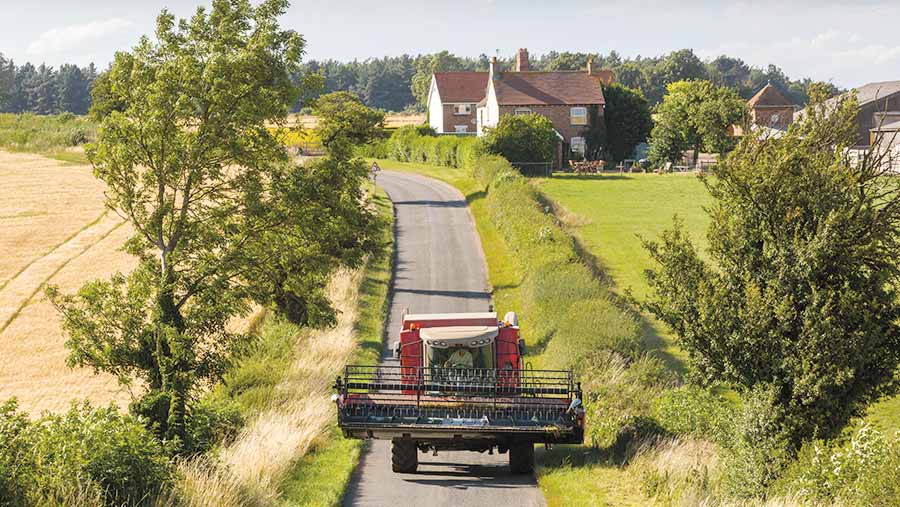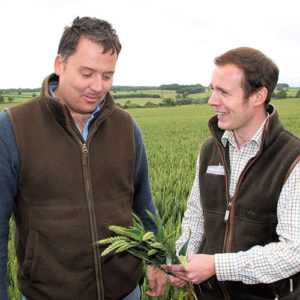How one farmer manages 2,400ha of cropping across 40 parcels
 © Tim Scrivener
© Tim Scrivener Managing 2,400ha of cropping across 40 parcels of land is no easy task. Leicestershire-based farming company Wright’s Agriculture is meeting this challenge, and achieving the highest production standards, thanks to effective use of new technology.
Father-and-son team Bill and Eric Wright run a complex and rapidly expanding business from their base at Saxelbye, near Melton Mowbray. They have established a highly professional reputation, thanks to constant surveillance and attention to detail.
There are 17 contract farms and a further 17 tenancies within a 25-mile radius, with 40 land parcels and 58 crop blocks, growing winter and spring cereals, winter oilseed rape and spring beans.
In addition, there is a six-strong full-time workforce, with 10 additional seasonal workers drafted in for harvest and drilling.
See also: Four growers share their experiences of controlled traffic farming
Nothing is left to chance when it comes to planning and carrying out fieldwork, with effective communication being central to the management function – both internally and with the company’s network of customers, suppliers and other stakeholders.
Eric Wright says it is innovative use of the latest communications technology that allows them to farm in the way that they do.
“The paperwork burden of a business with this type of structure is enormous,” he points out. “Apart from the sheer volume of work, without the right IT systems in place it would be difficult to get the detail and accuracy needed for management decision-making.
“We also have to provide up-to-date information to our landlords, agents and contract partners on a regular basis.”
In the farm office, the main computer runs Gatekeeper software, a complete crop recording and field management package.

Agronomist Harry Abell (left) with Eric Wright
Mr Wright’s agronomist, Harry Abell of Agrii, also has an electronic link to the system, for preparing and sending his spray recommendations, as well as viewing all the maps, plans and field records.
However, in order to make even better use of the information that the system holds, Mr Wright has invested in iPads for his team and uses file-sharing software Dropbox to make sure that they can access the latest field information, wherever they are.
Likewise, selected folders can be shared with others – including land agents, third-party agronomists and the farmers that he contracts for – avoiding the need for any paperwork duplication.
On the move
With so much to keep track of, Mr Wright does much of the office work remotely, using a laptop and TeamViewer software, so that he can update and share information on the move.
He has also extended its reach by including the business’s suppliers on Dropbox, so that all the deliveries can be recorded and accurate stock levels maintained.
“Together, it performs the logistics and personnel function,” he says. “I know where everyone is, what operation they are carrying out and how long it is taking them. In the same way, the team can fill in their timesheets and personal details.”
Maps produced by Batchgeo software ensure that team members can locate and find the different blocks of land, many of which are some distance from the main farm base.
The farm’s entire John Deere machinery fleet – consisting of three combines, two tracked tractors, six conventional tractors and another two hired tractors at harvest – is connected through JDLink. This allows Mr Wright to see any machine’s location, the hours worked, the amount of fuel used and its maintenance schedule.
“It also lets us plan workloads and machinery servicing, helping to minimise downtime and keep everything running efficiently,” he says.
Precision farming
An early adopter of precision farming, Mr Wright has been making the best possible use of GPS guidance, yield mapping, variable-rate applications and telematics for a number of years, with the support of his local John Deere dealer, Farol, and Agrii’s SoilQuest service.
This precision approach extends to all of the land that he oversees – with soil scanning and zoning of any new sites completed as part of the agreement as he takes them on, in order to be able to target inputs according to crop potential and soil type.
“We have been using variable-rate applications for fertiliser and seed for a while, with very good results,” he reveals. “But we have now extended that to include some of our spraying.”
This year, his T0 and T1 applications, as well as plant growth regulators, were applied according to satellite images of crop development, with fungicide rates varying by 30% across individual fields. “It hasn’t changed the amount of chemical that we have used, but it has redistributed it to where it’s justified.
“We are trying to push crops where there’s good potential, but we recognise that there are parts of fields that just don’t respond in the same way.”
Mr Wright is currently trying out Iteris software from Clarity Ag UK, which will give him details on the weather, soil conditions and crop development stages at individual sites and on blocks of land. This is considered crucial when making decisions about when and where to spray across a large geographical area.
“It has the potential to take us to the next level, and could be very helpful with the planning of our field operations and work schedules.”
Planning, purchasing and monitoring
Not surprisingly, Mr Wright’s eye for detail and use of technology extends to the business’s purchasing function.
He has established an agrochemical buying group, getting two tenders/year from four distributors, to take advantage of any economies of scale and offer discounts for his own and his contract farms’ agrochemical use. In 2015-16, it had a turnover of £500,000.
Similarly, he has two liquid fertiliser suppliers, each providing half of his total requirement.
“We have seen some good savings from this arrangement – across two half-year tenders, for 1,100cu m purchased in the 2015-16 growing season there was a saving of £14,600 between the two suppliers’ most competitive prices.”
However, flexibility within the machinery fleet has been retained, he stresses. “We still have the ability to use compound fertilisers, if the deal is better. But with two 36m self-propelled sprayers, we get far greater accuracy with liquids.”
All of the grain stores are monitored and managed in a similar way, with the records being held in Dropbox, so that they can be accessed from anywhere.
Cropping
Some 1,154ha of Group 1 milling wheat and 639ha of Holl oilseed rape are the biggest crop areas for Wright’s Agriculture, so that premium-earning opportunities can be exploited.
A recent introduction has been the quality spring wheat Mulika, which has given greater flexibility with its wide drilling window, without sacrificing yield and quality performance.
“We drill it in late autumn, which suits it very well,” says Mr Wright. “But it can wait right through until April, if necessary. So if the conditions aren’t right, we don’t have to drill and there’s no cost of seed carryover.”
Other milling varieties grown include Solstice, Crusoe and Skyfall, while 295ha of spring barley is a mixture of Propino and Explorer, with the latter being grown on contract for Budweiser. All of the 100ha of winter barley is Hyvido hybrids, with 159ha of spring beans making up the rest.
Over winter cover crops are being investigated for their nutrient capture and soil structure benefits, although Mr Wright admits to being sceptical.
“They bring additional expense, work and hassle. So it will be interesting to see if they make a difference.”
Proactive agronomy
A zero-tolerance policy is taken when it comes grass weeds and cereal diseases, with Eric Wright working closely with Agrii agronomist Harry Abell.
“Our strategy is proactive agronomy,” he explains. “We work on the basis that prevention is better than cure.”
As a result, both herbicide and fungicide programmes are heavily front-loaded, to ensure that crops remain clean.
“Chemical performance is declining, while disease and weed pressures seem to be increasing,” says Mr Wright. “This strategy keeps us ahead of any problems. It also helps with our forward purchasing and planning.”
Support from Syngenta’s direct-to-farm strategy, provided by Gareth Debenham, has helped create the proactive fungicide strategy model, as well as build knowledge of fungicide activity on the farm.
Fungicides are viewed as an investment, rather than a cost, while Mr Abell is employed on a fee-per-acre basis, so that agrochemicals can be purchased independently.

